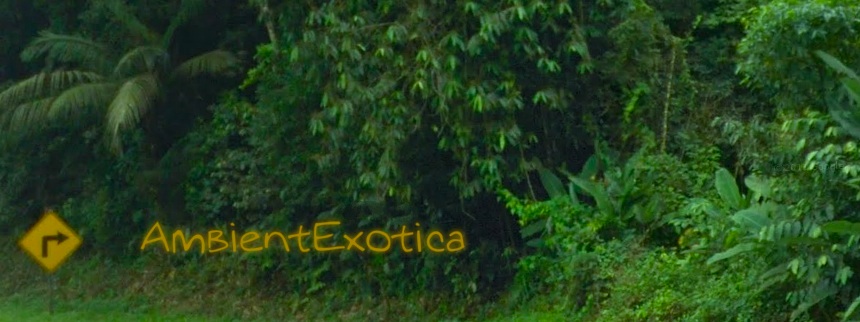
Orchestra Superstring
Kalopia
2012
Kalopia is the vinyl debut of the Los Angeles-based band of veterans called Orchestra Superstring with vibraphonist DJ Bonebrake at the helm. Released in 2012 on Dionysus Records whose runner Lee Joseph provided me with a digital copy for review purposes, the album gathers the best material off the band’s eponymous debut Orchestra Superstring (2003) plus the sophomore work Easy (2011), comprises of nine tracks full of Afro-Bop tunes, Tango compositions and even bluejacket shanties and grafts modern compositional wizardry onto these vintage Exotica tunes.
Orchestra Superstring is the sextet of DJ Bonebrake, percussionists Danny Frankel (bongos) and Debra Dobkin (congas), guitarist Woody Jackson, bassist Paul Eckman as well as trumpeter and accordion player Mike Bolger. This setup implies the possible range of the presented material, and the orchestra does not disappoint. The first surprise is already conjured up by the jazzy dimension the collective unleashes: this is no Rock band. With only two exceptions, the guitar is used as an accentuating or rhythmic device, so do not expect Surf or Rockabilly material. Much more frequently in use is the accordion, but the expectations or stereotype-fueled assumptions of the listener are yet again neglected. The accordion is not used to create Normandy landscapes. The range of the timbre and tonality sets this album apart from other new Exotica works. Another boon are the percussion boughs that drive each and every of the nine unique compositions. From dreaminess over melancholia to rougher experiments during the album's last third, Kalopia hides its hybrid status and does not reveal to the listener that two hearts (albums) are beating in its body. But other things are incessantly visible. Drums, for instance. And frilly melodies.
The street of the opener Silberstrasse may not be paved with gold, but silver is a an even glitzier metal whose colder effulgence is splendidly transformed into music by the means of DJ Bonebrake’s glacial vibe tones. In addition, the band underlines these recurrent billows with an excitingly autumnal-bucolic dose of French savoir vivre. Mike Bolger’s melancholic and retrogressive accordion melodies may reside on the opposite spectrum of the vibraphone’s sparkling impetus and the tropical verdure of the delicately hollow bongo and conga shrubbery, but notwithstanding the various origins and habitats of these instruments, Silberstrasse emanates both a profound plasticity and dualistic depth that are simply delightful. Add Woody Jackson’s sunset-colored guitar twangs of the Hawaiian kind to the scenery, and you’ve got a French chanson with Latin percussion, Polynesian carefreeness and a German title. Eclecticism is a street.
Follow-up Ambrosia is draped in warmer veils of thermal heat and hammock-friendly tempos. The downbeat susurration succeeds with the interplay between sound, sustain and silence. The guitar chords schlep themselves forward in an inebriated fashion, the timbre of the accordion boosts the sleazy slackery and inherits the aura of rustic landscapes. In addition, the aqueous-wooden percussion clicks – probably claves or castanets – add a sense of wideness to the scenery. Said sustain phases are superb as well, allowing the afterglow of each instrument’s reverb to conflate with the dreamscape. By no means ecstatic, let alone effervescent, Ambrosia is figuratively awash with Mediterranean light.
Easy is next and is another deeeeply ambiguous critter. Bongos, cowbells and hi-toms form the juicy base frame, but the girdling circumambience is designedly dubious. Quavering cascades of Hammond organs twirl along, jazzy vibraphone spirals gyrate around the shady lounge scenery, the whole arrangement feels like a laid-back, forsaken pirate grove somewhere near Barbados. Easy is by no means a Calypso, but its hatched colors and murky halftones make this an easygoing yet slightly tense downtempo sapphire which is more keen on a texture-related percussion prowess than memorable melodies. This is the jazziest, seemingly freely flowing and improvised tune of the album.
The follow-up Evidence then moves into African steppes and is distantly related to Les Baxter’s African Jazz (1958) and African Blue (1969) because of Mike Bolger’s prominent trumpet eruptions and the liquedous-moist percussion thicket of djembes, bongos and congas whose omnipresent midtempo shrapnel is curiously benign and completely devoid of any voodoo spell. Add downwards spiraling galactosamine organs and Paul Eckman’s double bass blebs to the scenery, and you are in for a faux-African nonhazardous safari. No Sho is next and widens the instrumental pool once again, this time in tandem with its amicability, for there is no dark counterpoint woven into any of the blissful fibers. The accordion waves are sun-dried and euphonious, turquoise-tinted pointillistic punctilios of the marimba kind orbit around the double bass-accentuated fundament. A shanty at its core and interpolated by Brazillian kettle drums next to the bongo runlets, No Sho is a positively smarmy corker that encapsulates the listener in uplifting technicolor mirages of yore. They don’t make tunes like this anymore. No, wait… they do!
Elbason is a somewhat camouflaged Tango which literally begs for accordion aortas, and these are naturally in place, but the focus shifts away from their presence and turns to heavily pulsating vibraphone undulations, dun-colored guitar chords and a love-crazed aurora of fiery devotion and passion. That the tone sequences range in minor climes is a given. However, this is still no commonplace Tango due to the voluminous percussion protuberances which occasionally elbow their way through the foreground from behind. A polymorphous intertwinement. The eponymous Kalopia moves to Florida, or to be more precise, the whitewashed skyscrapers of Miami. Even though there are no synths or overblown drums in place, a city-strolling scheme is nonetheless evoked by acidic double bass twangs, gruntling electric guitar stabs and dissonant organ washes as well as sleazy vibraphone dots. Traces of show tune grandiloquence are looming in the concrete chaparral, but this is, at the end of the day, a seemingly burlesque pandemonium of Rockabilly, or alternatively, a bath in alkaline liquids, raw and raucous, less exotic than incisive.
Waterbed at first continues the noisier paths with amplified AM frequency-like dial tone-evoking seesaw glitches, but soon enough, this strange asbestus coil is placed in an infusion of glacial vibraphone sprinkles, vesiculating bongos, cowbells and plinking sticks. When all elements are firmly in place, the dazzling glitchscape suddenly ennobles the exoticism and gives this loungerie a harder edge without destroying the build-up. Closer Mambalita then goes all-in on the Latin craze with melodramatic trumpet tones, archetypical tone sequences of devotion and fire on the guitar. A bongo galore as well as vibraphone shards pass by as well. Torn between a fiery seriousness and multifaceted interlocks, Mambalita finishes off the increasingly sanguine sequence of material with a besotted bang. Ugh.
Kalopia unites the best artifacts of two albums, and not only can I relate to the idea and raison d’être, I also applaud DJ Bonebrake and his Orchestra Superstring fellows for the stylistic assurance of the presented material. It draws from the tropics, steppes, savannas, deserts and even city beachsides, thus uniting the languorous far-away places of the world with the picturesque serpentines, alleyways and lanes of Old Europe. The implication of the latter is mostly invoked by the ubiquity of the accordion, whereas the piercing trumpet bursts are reminders of the South American way of life. Thankfully enough, both instruments are played by Mike Bolger who is therefore one very important part of the setup, unraveling slivers of threnody, specks of lachrymosity and cornucopias of genuine warmth.
The accordion is not even that curious an instrument in the realms of Exotica, not anymore since Milt Raskin’s eternal opus Kapu and Dominic Frontiere's Pagan Festival (both 1959). Bolger, however, manages to precisely control the effect of these instruments. The accordion does not sound French all the time, nor is the trumpet tied to Latin grandeur. Likewise, DJ Bonebrake’s vibraphone and marimba segments are incredibly colorful and varied. His prestidigitation either leads to transfiguring phantasmagorias, a refreshing iciness or expanding levels of glee. Whatever the respective arrangement is in need of, the vibraphonist is able to deliver, both in the spotlight and as an accompanying benefactor. Percussionists Danny Frankel and Debra Dobkin round the material off in tandem with bassist Paul Eckman and guitarist Woody Jackson; the guitar remains curiously under the radar most of the time and is usually used as a rhythmic device, but this only adds to the impression of listening to a big band or small orchestra rather than a Rockabilly supergroup. The density of the percussion and its various surfaces and patterns are top-notch as well, making Kalopia an excitingly polyfaceted Exotica album. The last string of three tracks is purposely forceful and staggering, but still perfectly exotic. Kalopia is available on vinyl and as a download version directly from Dionysus.
Exotica Review 281: Orchestra Superstring – Kalopia (2012). Originally published on Nov. 9, 2013 at AmbientExotica.com.
